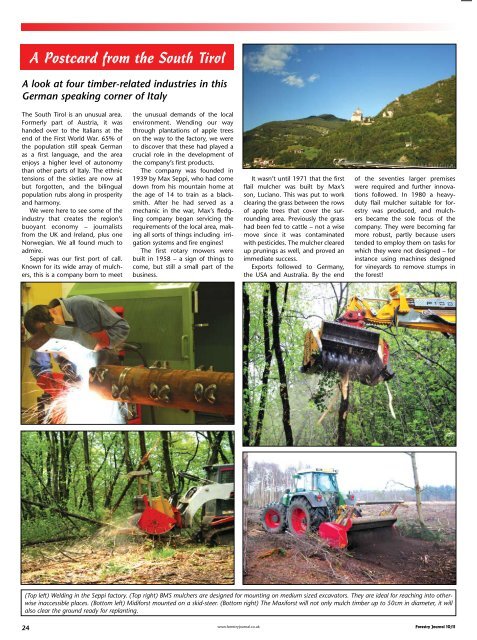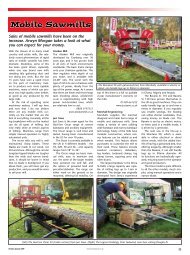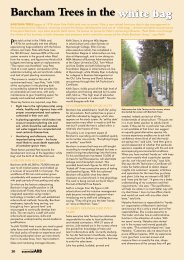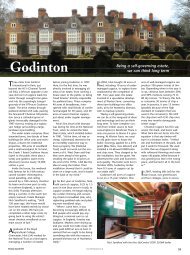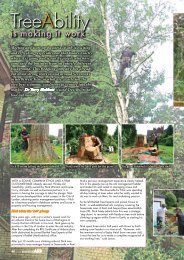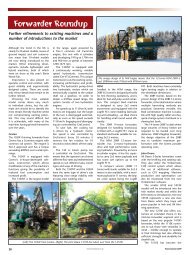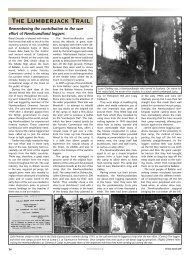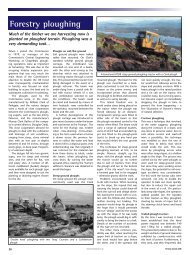A Postcard from the South Tirol - Forestry-Journal-essentialARB
A Postcard from the South Tirol - Forestry-Journal-essentialARB
A Postcard from the South Tirol - Forestry-Journal-essentialARB
- No tags were found...
Create successful ePaper yourself
Turn your PDF publications into a flip-book with our unique Google optimized e-Paper software.
A <strong>Postcard</strong> <strong>from</strong> <strong>the</strong> <strong>South</strong> <strong>Tirol</strong>A look at four timber-related industries in thisGerman speaking corner of ItalyThe <strong>South</strong> <strong>Tirol</strong> is an unusual area.Formerly part of Austria, it washanded over to <strong>the</strong> Italians at <strong>the</strong>end of <strong>the</strong> First World War. 65% of<strong>the</strong> population still speak Germanas a first language, and <strong>the</strong> areaenjoys a higher level of autonomythan o<strong>the</strong>r parts of Italy. The ethnictensions of <strong>the</strong> sixties are now allbut forgotten, and <strong>the</strong> bilingualpopulation rubs along in prosperityand harmony.We were here to see some of <strong>the</strong>industry that creates <strong>the</strong> region’sbuoyant economy – journalists<strong>from</strong> <strong>the</strong> UK and Ireland, plus oneNorwegian. We all found much toadmire.Seppi was our first port of call.Known for its wide array of mulchers,this is a company born to meet<strong>the</strong> unusual demands of <strong>the</strong> localenvironment. Wending our waythrough plantations of apple treeson <strong>the</strong> way to <strong>the</strong> factory, we wereto discover that <strong>the</strong>se had played acrucial role in <strong>the</strong> development of<strong>the</strong> company’s first products.The company was founded in1939 by Max Seppi, who had comedown <strong>from</strong> his mountain home at<strong>the</strong> age of 14 to train as a blacksmith.After he had served as amechanic in <strong>the</strong> war, Max’s fledglingcompany began servicing <strong>the</strong>requirements of <strong>the</strong> local area, makingall sorts of things including irrigationsystems and fire engines!The first rotary mowers werebuilt in 1958 – a sign of things tocome, but still a small part of <strong>the</strong>business.It wasn’t until 1971 that <strong>the</strong> firstflail mulcher was built by Max’sson, Luciano. This was put to workclearing <strong>the</strong> grass between <strong>the</strong> rowsof apple trees that cover <strong>the</strong> surroundingarea. Previously <strong>the</strong> grasshad been fed to cattle – not a wisemove since it was contaminatedwith pesticides. The mulcher clearedup prunings as well, and proved animmediate success.Exports followed to Germany,<strong>the</strong> USA and Australia. By <strong>the</strong> endof <strong>the</strong> seventies larger premiseswere required and fur<strong>the</strong>r innovationsfollowed. In 1980 a heavydutyflail mulcher suitable for forestrywas produced, and mulchersbecame <strong>the</strong> sole focus of <strong>the</strong>company. They were becoming farmore robust, partly because userstended to employ <strong>the</strong>m on tasks forwhich <strong>the</strong>y were not designed – forinstance using machines designedfor vineyards to remove stumps in<strong>the</strong> forest!(Top left) Welding in <strong>the</strong> Seppi factory. (Top right) BMS mulchers are designed for mounting on medium sized excavators. They are ideal for reaching into o<strong>the</strong>rwiseinaccessible places. (Bottom left) Midiforst mounted on a skid-steer. (Bottom right) The Maxiforst will not only mulch timber up to 50cm in diameter, it willalso clear <strong>the</strong> ground ready for replanting.24www.forestryjournal.co.uk<strong>Forestry</strong> <strong>Journal</strong> 10/11
(Left) This model, designed for <strong>the</strong> glulam industry, can be tilted up to 90º. (Right) ES 1050 working on a spruce log taken <strong>from</strong> <strong>the</strong> surrounding hills.Johann Resch began <strong>the</strong> productionof new saws.After operating <strong>the</strong> company for50 years, Johann and Ignaz Reschhanded it over to three of <strong>the</strong>ir longtermemployees in January 2006.Thus it became Resch & 3, with anew logo and corporate style.Resch & 3 now has 10 employeesand turns out 8 to 10 machines ayear. Each machine is different, and<strong>the</strong> company makes <strong>the</strong> parts itself.The static bandmill predominatesnowadays, since it is no longer soproblematic to transport logs. Infact, <strong>the</strong> ratio of static to mobilemills is 10 to 1. Resch & 3 sawmillsare high-end machines costingbetween e100,000 and e200,000,and are tailored to <strong>the</strong> customer’srequirements.The sawmills are available in electricor diesel powered models, withwheel diameters of 1,050, 1,200 or1,400mm. The Profi models comewith a cab, <strong>the</strong> Eco models without.There are also versions designedspecifically for <strong>the</strong> glulam industry,on which <strong>the</strong> whole headrig can betilted by up to 90º.Accuracy of cut on Resch & 3sawmills is assisted by pressureguides that support <strong>the</strong> blade whencutting, and automatic log measuringgives a readout of <strong>the</strong> volumecut over <strong>the</strong> day.The list of optional extras isimpressive. They include doubleprecutters that pass along <strong>the</strong> rawlog, removing any dirt and debris,ensuring a good entry and exitfor <strong>the</strong> sawblade. This dramaticallyincreases <strong>the</strong> maintenance intervalfor <strong>the</strong> saw teeth.A cross-cutter is available that willtrim planks to <strong>the</strong> desired length,meaning finished lengths of timbercan be taken directly <strong>from</strong> <strong>the</strong> mill.Hydraulically actuated, <strong>the</strong> crosscutsaw can also be rotated by 90º andused as a ripping saw. In beech thiscan be used to relieve tension in <strong>the</strong>log to stop it breaking when cutwith <strong>the</strong> bandsaw.Resch & 3 also make much of<strong>the</strong>ir long experience in caring for<strong>the</strong> saw blades, and <strong>the</strong>y offer aportable automatic sharpener. Thiscan be attached to a sawmill and setto work sharpening one blade while<strong>the</strong> mill continues cutting usingano<strong>the</strong>r one.Then <strong>the</strong>re are automatic plankremovers or gripper tongs to lift<strong>the</strong> sawn wood clear. There is evena double-sided brush machine toremove sawdust, especially <strong>from</strong>beech, where it would o<strong>the</strong>rwise(Top left) The touch-screen in <strong>the</strong> cab of <strong>the</strong> ES 1050. (Top centre) The crosscutting circular saw can be used to trim to length, and can also be turned through90º to cut longitudinally. (Top right) Pressure guides keep <strong>the</strong> blade in position to ensure an accurate cut. (Bottom left) Turning chains can be used to rotate <strong>the</strong>log to <strong>the</strong> desired position, and are also used to eject sawn timber. (Bottom centre) Precutters clean <strong>the</strong> log to ensure a clean entry and exit for <strong>the</strong> saw blade,dramatically extending maintenance intervals. (Bottom right) The automatic blade sharpener in action.26www.forestryjournal.co.uk<strong>Forestry</strong> <strong>Journal</strong> 10/11
(Above) No more surprises: Microtec offer <strong>the</strong> possibility of seeing exactlywhat lurks inside a log before it is cut. (Right) The revolving gantry of <strong>the</strong> CTscanner that X-rays <strong>the</strong> logs as <strong>the</strong>y pass through it, and (bottom right) <strong>the</strong>scanner seen in context on <strong>the</strong> conveyor. (Bottom left) Goldeneye using lasersand colour cameras to record each plank as it passes – with four sets of sensors,one for each side.stain <strong>the</strong> timber blue.As well as horizontal bandmills,Resch & 3 also make circular edgingsaws and have recently addeda double circular edger to <strong>the</strong>irrange.www.resch-3.comThe final visit was to Microtec, whoare world leaders in <strong>the</strong> scanningof timber in sawmills. They haveinstallations on every continent –everywhere where pine and sprucegrow, in fact.Founded in 1980, Microtec hasa turnover of e29million, with 10%of this being ploughed back intoR&D. Much of <strong>the</strong> technology <strong>the</strong>yoffer has a medical background, butinstead of scanning people, <strong>the</strong>yscan wood.By using a very wide spectrum ofwavelengths <strong>the</strong>y are able to derivemuch more information <strong>from</strong> eachpiece of timber scanned. The moreinformation <strong>the</strong>y get, <strong>the</strong> easier it isto interpret. Thus <strong>the</strong>y supplement<strong>the</strong> visible part of <strong>the</strong> spectrum with3D laser scanning, X-ray imaging,laser scattering, polarised light scanning,ultrasound analysis, and radioand microwave scanning.At <strong>the</strong> end of all that, <strong>the</strong>re isnot much you don’t know abouta piece of wood, whe<strong>the</strong>r it’s <strong>the</strong>position of knots, surface defects,moisture content, curvature, moduleof elasticity, module of rupture,density etc.We were taken to see Microtec’sCT scanner. As machines go, thisis marginally more impressive than<strong>the</strong> Hadron collider. CT stands forcomputer tomography, and <strong>the</strong>machine uses a large X-ray sensorrotating around passing timber tobuild up a full 3D image of <strong>the</strong> log,warts and all.The scanner was turning at asedate speed with <strong>the</strong> cover openfor our visit. In practice it rotates at120 to 180 rpm, enabling it to keepup with logs passing at <strong>the</strong> industryspeed of over 2 metres a second,recording every fibre, every knot.A force of 60g is generated on <strong>the</strong>outer edge of <strong>the</strong> gantry, which has<strong>the</strong> same kinetic energy as a 3-tonnevehicle travelling at 75mph!As you may or may not know,tomography applies to planes – 2Dobjects. It is one thing generatingdata about every point within a log,but how can <strong>the</strong> information beinterpreted to give a 3D image? *Microtec enlisted <strong>the</strong> help ofRussian ma<strong>the</strong>matician AlexanderKatsevich to answer this question.The solution he came up with isnot merely a breakthrough in ma<strong>the</strong>matics,it is very valuable intellectualproperty. Even if someonewere to clone <strong>the</strong> CT scanner, <strong>the</strong>ywould be unable to interpret <strong>the</strong>data it generates without solvingthis problem.Armed with all this information,it is possible to optimise <strong>the</strong> cuttingof <strong>the</strong> log, so <strong>the</strong> best productsare derived <strong>from</strong> it and wastage isminimised. Microtec offers all <strong>the</strong>software necessary to make thispossible.We were also given a demonstrationof ano<strong>the</strong>r Microtec product,Goldeneye. This uses colourcameras, laser and X-ray technologiesto identify defects in planks– cracks, wane, knots, curvature,surface imperfections, etc. Microtecsoftware is vertically integrated, ando<strong>the</strong>r modules can be used alongsideGoldeneye to track individualboards as <strong>the</strong>y pass through <strong>the</strong>mill, determine <strong>the</strong>ir density andmoisture content and stress grade<strong>the</strong>m.O<strong>the</strong>r products in <strong>the</strong> Microtecportfolio include Logeye, Maxicutand Variosort.Logeye is aimed more at <strong>the</strong>log yard than Goldeneye, which issuitable for secondary manufacturingfacilities. Maxicut and Variosortare more or less self-explanatory.Maxicut maximises recovery by volume,by individual quality requirementsand/or product mix. Variosortallocates each piece of timber to <strong>the</strong>correct sort bin.With <strong>the</strong>ir wide array of solutions,it is difficult to imagine <strong>the</strong>reis any requirement in a sawmill thatMicrotec cannot meet, no matterhow fast <strong>the</strong> logs are passingthrough. www.microtec.eu* 2D data is interpreted using <strong>the</strong>Radon transform, named afterBohemian ma<strong>the</strong>matician JohannRadon (who solved <strong>the</strong> problem in1917), and used in tomographicreconstruction. Microtec’s challengewas far more complex: to find a formulato interpret 3D data.<strong>Forestry</strong> <strong>Journal</strong> 10/11 www.forestryjournal.co.uk27


